
Group-Based Interventions for 'Understanding Brain Injury'
Routledge (Verlag)
978-1-032-57951-1 (ISBN)
The chapters in the manual mirror the structure of the eight sessions of the group, highlighting differing aspects of having a brain injury. Initially, the sessions cover psychoeducation regarding brain injury and what neurorehabilitation entails. Following this, the group then focuses on living with the consequences of brain injury, whether that represents physical, cognitive, emotional or lifestyle changes. Participants are invited to share their experiences and discuss coping strategies to help with both the new limitations as well as the unwanted emotions that frequently exist after brain injury. Goals are set at the beginning of the group and are revisited at the end to decide on whether they were being realistic, overachieving or pessimistic in their outlook at the start of the group. Throughout, the members of the group can record their session activity in the accompanying workbook.
Created to be used by clinicians, therapists or any individual, this resource can be used in a post-acute setting such as a neurorehabilitation unit, a slow-stream rehab setting such as community neurorehabilitation or homes specifically aimed at catering for the needs of those with neurological impairments.
Dr Rebekah Jamieson-Craig is a qualified Clinical Psychologist from University College London, UK, and is currently employed by Barts Health NHS Trust. Throughout her career, she has had an interest in neurological conditions, and has worked within a brain injury neurorehabilitation unit, as well as several other neurorehabilitation settings.
1. Why create this manual?
2. Introducing the group
3. Session 1 – What is the Understanding Brain Injury group?
4: Session 2 – The brain and brain Injury
5. Session 3 – What is rehabilitation?
6. Session 4 – Physical changes after brain Injury
7. Session 5 – Thinking changes after brain Injury
8. Session 6 – Mood and behaviour changes after brain Injury
9. Session 7 – Lifestyle changes after brain Injury
10. Session 8 – My goals for the future
Appendices
Appendix 1. Areas of the brain
Appendix 2. List of physical vhanges
Appendix 3. Example spider diagram of physical changes
Appendix 4. List of cognitive changes
Appendix 5. Example spider diagram of thinking ability changes
Appendix 6. Example spider diagram of mood and behaviour changes
Appendix 7. List of lifestyle changes
Appendix 8. Example spider diagram of lifestyle changes
Appendix 9. Certificate of attendance
Patient Workbook
| Erscheinungsdatum | 28.12.2023 |
|---|---|
| Zusatzinfo | 183 Line drawings, black and white; 3 Halftones, black and white; 186 Illustrations, black and white |
| Verlagsort | London |
| Sprache | englisch |
| Maße | 156 x 234 mm |
| Gewicht | 176 g |
| Themenwelt | Geisteswissenschaften ► Psychologie ► Allgemeine Psychologie |
| Geisteswissenschaften ► Psychologie ► Biopsychologie / Neurowissenschaften | |
| Medizin / Pharmazie ► Medizinische Fachgebiete ► Psychiatrie / Psychotherapie | |
| ISBN-10 | 1-032-57951-X / 103257951X |
| ISBN-13 | 978-1-032-57951-1 / 9781032579511 |
| Zustand | Neuware |
| Informationen gemäß Produktsicherheitsverordnung (GPSR) | |
| Haben Sie eine Frage zum Produkt? |
aus dem Bereich


